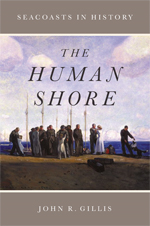John R. Gillis on Post-Sandy America
The devastation wrought by Hurricane Sandy to the Mid-Atlantic and Northeastern United States, the Caribbean, and Eastern Canada continues to exceed early damage estimates, with almost 66 billion dollars in losses currently anticipated for the US alone, and a death toll of 253 afflicting seven nations. In his recent book The Human Shore: Seacoasts in History, John R. Gillis articulates—and even anticipates—how our relationship to the sea has begun to take on new and potentially catastrophic dimensions. Accounting for more than 100,000 years of seaside civilization, Gillis argues that in spite of mass movement to the coasts in the last half-century, we have forgotten how to live with our oceans. Applying this knowledge to our tenuous responses to this most recent disaster, Gillis explains how a shift in education, awareness, and planning might yet allow us to learn the lessons necessary for sustainable coinhabitance with the seas. You can read more of his thoughts on what we can do below.
***
“History Has Lessons for Post-Sandy America” by John R. Gillis
In the wake of Hurricane Sandy, Americans are finally beginning to ask themselves whether or not it might be advisable to build up to the edge of the sea. It is dawning on us that we are dealing with a human-made rather than natural disaster. The surge of populations to the sea has been accelerating in recent decades and losses have begun to mount astronomically as expensive properties, encouraged by federally-subsidized insurance, crowd the seashore. On American coasts, a culture of coping—the product of thousands of years of human habitation, on shores that began in prehistoric Africa and ultimately circled the globe—is rapidly vanishing.
Our ancestors knew not just how to live on the sea, but with it. They came there to enjoy the most productive environment the world could offer: in terms of what the land could provide, as well as the even-richer marine biota located just offshore. First as hunters and gatherers, and later assisted by sail and ultimately steam, coastal societies generated social and economic resources greater than their inland neighbors. In the early modern period, it was by means of seaborne empires that Europe extended its world dominance. The United States was born coastal, discovered and settled by sea. In 1837, Alexis de Tocqueville predicted for the young republic a glorious maritime future. The opening up of the North American continent ultimately turned this country inward, but it has always been multishored, facing out toward the Atlantic, Pacific, and the Gulf.
America’s native people had been farmer-fishers. The Europeans who followed them were similar in their orientation to both land and sea. These settlers, like the hunter-gatherers they replaced, were highly mobile, moving alongshore in search of their livelihood. They built dwellings of light, transportable materials and when they settled permanently, they confined themselves well back from the sea, often facing away from what they knew to be its ever-present dangers. These people were not risk-averse, but they were well-informed and cautious about the ways of the sea. Their beaches were strewn with wrecks, as testimony to the uncontrolled power of the oceans to take, as well as give, life. They did not ask to be rescued but instead coped as communities.
In the late twentieth century, older coastal inhabitants have been largely displaced by interior populations who have come to shore to recreate rather than earn their livings. These new residents have confined the fishers to a few small ports, taking over the beaches between, and clearing away even the memories of working life, not to mention the life-and-death struggles that once played out on the seas. Today, the beach is supposed to be the place where we get away from the world—and even the thought of its troubles. Fishing villages have now been turned into some of the world’s highest-priced real estate, forcing fishers and clammers to live elsewhere, as they commute to the few working waterfronts that still exist. In most places, these have been replaced by what John Cheever called a “second shore,” ports of “antique shops, restaurants, and tea shops.”
Gone are not only the old coastal peoples but their well-developed cultures of risk and coping. Risk has been displaced to the national treasury; coping is left to governments at the state and federal levels. This new coastal generation no longer knows how to live lightly on the shores or how to construct portable buildings that can be removed from the path of danger. Earlier generations knew the sea to be an ever-present risk, but did not treat it as an enemy from which there can be no retreat. Americans now fly flags in the face of hurricanes and resist the pulling back of lighthouses threatened by beach erosion as a betrayal of national sovereignty.
The first response of politicians to Sandy—to restore and rebuild in place—was not at all promising, but there is still time for wiser counsel. Already there have been calls for risk to be gradually shifted from the government to property owners. Instead of quick fixes like manufacturing bigger sea walls and expensive storm barriers, we can wait for nature to do its part by rebuilding barrier islands and wetlands. But we also need to do our part by educating the public on the history and culture of risk and coping. We can do the first by taking financial responsibility for our own mistakes. The second can be accomplished by sensible coastal planning and new building codes that are informed by the history of local resilience, which has much offer if we are only willing to consult its long record.
John R. Gillis is the author of The Human Shore: Seacoasts in History; Islands of the Mind; A World of Their Own Making: Myth, Ritual, and the Quest for Family Values; and Commemorations. A professor of history emeritus at Rutgers University, he now divides his time between two coasts: Northern California and Maine.
